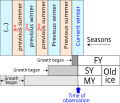Sea ice
Sea ice refers to frozen ocean water that forms, expands, and melts in the ocean. It is found in the Arctic Ocean, around Antarctica, and in the seas within the Arctic Circle. Sea ice influences the global climate system, serves as a habitat for various marine species, and affects human activities such as shipping and fishing.
Formation and Types[edit]
Sea ice forms when the temperature of ocean water drops below the freezing point, which is slightly below 0°C due to the salt content in the water. The process begins with the formation of ice crystals that eventually coalesce into larger ice structures. There are two main types of sea ice: first-year ice, which is ice that has formed in the current winter, and multi-year ice, which has survived at least one summer melt season.
Characteristics[edit]
The characteristics of sea ice vary depending on its age, thickness, and the environment in which it forms. Younger ice is typically thinner and more susceptible to melting, while older ice is thicker and more resilient. The surface of sea ice can be smooth or rough, with features such as pressure ridges and leads (openings in the ice).
Importance[edit]
Sea ice plays a crucial role in the Earth's climate system by reflecting sunlight back into space (albedo effect) and insulating the relatively warm ocean from the colder atmosphere. It also contributes to the global ocean circulation by releasing salt into the ocean as it forms, which affects the density and buoyancy of seawater.
Ecosystems[edit]
The sea ice environment supports unique ecosystems, including algae that live within and beneath the ice, which serve as a foundational element of the marine food web. Animals such as polar bears, seals, and various species of birds depend on sea ice for hunting, breeding, and resting.
Human Impact[edit]
Human activities, particularly greenhouse gas emissions, have contributed to significant changes in sea ice extent and thickness. The reduction of sea ice has implications for global climate patterns, marine ecosystems, and indigenous communities that rely on sea ice for traditional ways of life.
Observation and Study[edit]
Scientists study sea ice through a combination of satellite observations, field measurements, and computer models. This research helps to improve our understanding of sea ice dynamics, its role in the climate system, and the potential impacts of its changes.
Challenges and Future Outlook[edit]
The future of sea ice is uncertain, with models predicting further reductions in extent and thickness due to global warming. Understanding and mitigating the impacts of these changes is a critical challenge for the global community.

This article is a oceanography stub. You can help WikiMD by expanding it!
-
Arctic ice
-
Sea ice Drawing General features
-
Nilas Sea Ice
-
FY vs SY vs MY
-
Sea ice near coast of Labrador
-
Ikaasaartik strait ice floes aerial
-
Greenland East Coast
-
Ryuhyoh
-
Hummock
-
Pressure ridge -- where two ice floes meet
Ad. Transform your life with W8MD's Budget GLP-1 injections from $75


W8MD offers a medical weight loss program to lose weight in Philadelphia. Our physician-supervised medical weight loss provides:
- Weight loss injections in NYC (generic and brand names):
- Zepbound / Mounjaro, Wegovy / Ozempic, Saxenda
- Most insurances accepted or discounted self-pay rates. We will obtain insurance prior authorizations if needed.
- Generic GLP1 weight loss injections from $75 for the starting dose.
- Also offer prescription weight loss medications including Phentermine, Qsymia, Diethylpropion, Contrave etc.
NYC weight loss doctor appointmentsNYC weight loss doctor appointments
Start your NYC weight loss journey today at our NYC medical weight loss and Philadelphia medical weight loss clinics.
- Call 718-946-5500 to lose weight in NYC or for medical weight loss in Philadelphia 215-676-2334.
- Tags:NYC medical weight loss, Philadelphia lose weight Zepbound NYC, Budget GLP1 weight loss injections, Wegovy Philadelphia, Wegovy NYC, Philadelphia medical weight loss, Brookly weight loss and Wegovy NYC
|
WikiMD's Wellness Encyclopedia |
| Let Food Be Thy Medicine Medicine Thy Food - Hippocrates |
Medical Disclaimer: WikiMD is not a substitute for professional medical advice. The information on WikiMD is provided as an information resource only, may be incorrect, outdated or misleading, and is not to be used or relied on for any diagnostic or treatment purposes. Please consult your health care provider before making any healthcare decisions or for guidance about a specific medical condition. WikiMD expressly disclaims responsibility, and shall have no liability, for any damages, loss, injury, or liability whatsoever suffered as a result of your reliance on the information contained in this site. By visiting this site you agree to the foregoing terms and conditions, which may from time to time be changed or supplemented by WikiMD. If you do not agree to the foregoing terms and conditions, you should not enter or use this site. See full disclaimer.
Credits:Most images are courtesy of Wikimedia commons, and templates, categories Wikipedia, licensed under CC BY SA or similar.
Translate this page: - East Asian
中文,
日本,
한국어,
South Asian
हिन्दी,
தமிழ்,
తెలుగు,
Urdu,
ಕನ್ನಡ,
Southeast Asian
Indonesian,
Vietnamese,
Thai,
မြန်မာဘာသာ,
বাংলা
European
español,
Deutsch,
français,
Greek,
português do Brasil,
polski,
română,
русский,
Nederlands,
norsk,
svenska,
suomi,
Italian
Middle Eastern & African
عربى,
Turkish,
Persian,
Hebrew,
Afrikaans,
isiZulu,
Kiswahili,
Other
Bulgarian,
Hungarian,
Czech,
Swedish,
മലയാളം,
मराठी,
ਪੰਜਾਬੀ,
ગુજરાતી,
Portuguese,
Ukrainian








